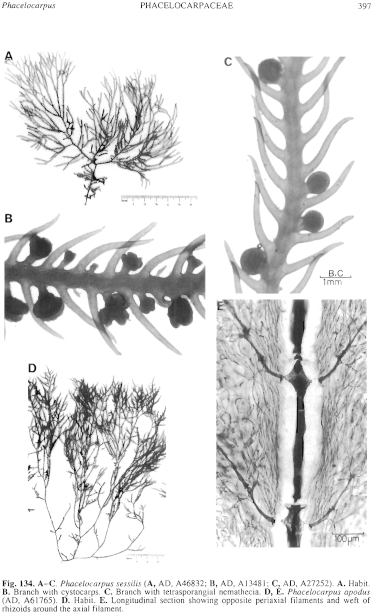|
|
|
|
|
|||||||||||
|
Electronic Flora of South Australia Species Fact Sheet
Phylum Rhodophyta – Class Florideophyceae – Order Gigartinales – Family Phacelocarpaceae
Selected citations: Adams & Nelson 1985: 21. De Toni 1900: 392. Kylin 1932: 52, pl. 19 fig. 46. Searles 1968: 16, fig. 6, pl. 3.
Thallus (Fig. 134A) medium red to red-brown, (5–) 10–30 cm high, with a terete stipe 2–15 mm long and 0.7–1.3 mm in diameter, much branched complanately with terete rachides of decreasing length for 4–6 orders, rachis 1–1.3 mm in diameter below, 400–800 µm in diameter in mid parts and 200–300 µm in diameter in upper branches; rachis in mid parts terete to slightly compressed, sometimes with a slight lateral protrusion between the ramuli. All branches bearing distichous, alternate, terete ramuli (Fig. 134C) 1–1.5 (–2) mm long, 150–250 µm in basal diameter and tapering gradually to 100–150 µm in diameter near their apices, then to a point, becoming separated on the rachis by 3–5 times their basal diameter (often closer in the lower thallus). Holdfast discoid, 2–4 mm across; epilithic or rarely epiphytic. Structure uniaxial, developing a prominent axial filament with four periaxial cells, the lateral two more strongly developed with alternate ones forming the ramuli; rhizoids relatively weakly developed around the axial filament. Cortex pseudoparenchymatous, inner cells ovoid and 20–50 µm in diameter, outer cells 3–5 µm in diameter and L/D 1–1.5; refractive cortical cells common; rhodoplasts discoid, small, few per cell.
Reproduction: All reproductive bodies borne on the rachis, developed from the periaxial filaments opposite a ramulus. Sexual thalli dioecious. Procarps with two 2-celled carpogonial branches and an auxiliary cell. Cystocarps (Fig. 134B) on a medium to long stalk, compressed, ovate and strongly bilabiate, 400–700 µm broad, with a thick pericarp along the ostiolar slit, enclosing the carposporophyte with a basal fusion cell and erect gonimoblast filaments with single terminal carposporangia. Spermatangia in channels in globular, sessile or short-stalked nemathecia 400–800 µm in diameter.
Tetrasporangia in sessile or subsessile globular to ovoid nemathecia (Fig. 134C) 400–600 µm in diameter, separated by tufts of sterile filaments, 30–65 µm long and 6–10 µm in diameter, zonately divided.
Type from southern Australia (Curdie); holotype in Herb. Agardh, LD, 28501.
Selected specimens: Point Peron, W. Aust., drift (Cribb 69.19, 15.viii.1950; AD, A13968). Cowaramup Bay, W. Aust. (Scagel, 27.viii.1962; AD, A43436). Elliston, S. Aust., drift (Womersley, 13.i.1951; AD, A13481). Pearson Is, S. Aust., 30–32 m deep (Shepherd, 7.i.1969; AD, A33684). Topgallant I., S. Aust., 35 m deep, epiphytic on a fucalean alga (Branden, 2.vii.1987; AD, A57555). Avoid Bay, S. Aust., drift (Womersley, 30.xi.1975; AD, A46832). Between Hopkins and Thistle Is, S. Aust., 6–9 m deep (Baldock, 1.i.1964; AD, A27105). Wedge I., S. Aust., 8–10 m deep (Baldock, 29.xii.1963; AD, A27252). Stenhouse Bay, S. Aust., drift (Womersley, 9.iv.1950; AD, A13243). Vivonne Bay, Kangaroo I., S. Aust., drift (Womersley, 14.i.1947; AD, A6903). Point Tinline, Kangaroo I., S. Aust., drift (Womersley, 2.ii.1956; AD, A20348). Port MacDonnell, S. Aust., drift (Womersley, 28.i.1964; AD, A27385). Dutton Bay, Portland, Vic., drift (Womersley, 13.iv.1959; AD, A22679). Orford, Tas. (Perrin & Lucas, Mar. 1935; Perrin 519 in BM).
Distribution: Three Kings Islands, New Zealand(?).
Point Peron, W. Aust., to Portland, Vic., and SE Tasmania, in deeper water on rough-water coasts.
Taxonomic notes: P. sessilis is usually readily recognised by its terete rachides and ramuli with the latter becoming widely separated, but occasional intergrades with P. apodus do occur. The specimens from New Zealand are not typical of P. sessilis and more like P. labillerdieri var. novae-zelandiae Chapman.
References:
ADAMS, N.M. & NELSON, W.A. (1985). The marine algae of the Three Kings Islands. A list of species. Nat. Mus. N.Z., Misc. Ser. No. 13, pp. 1–29.
AGARDH, J.G. (1876). Species Genera et Ordines Algarum. Vol. 3, Part 1 - Epicrisis systematis Floridearum, pp. i-vii, 1–724. (Weigel: Leipzig.)
DE TONI, G.B. (1900). Sylloge Algarum omnium hucusque Cognitarum. Vol. 4. Florideae. Sect. 2, pp. 387–776. (Padua.)
KYLIN, H. (1932). Die Florideenordnung Gigartinales. Lunds Univ. Årsskr. N.F. Avd. 2, 28 (8), 1–88, Plates 1–28.
SEARLES, R.B. (1968). Morphological studies of red algae of the order Gigartinales. Univ. Calif Pubis Bot. 43, vi + 1–86, Plates 1–12.
The Marine Benthic Flora of Southern Australia Part IIIA complete list of references.
Publication:
Womersley, H.B.S. (14 January, 1994)
The Marine Benthic Flora of Southern Australia
Rhodophyta. Part IIIA, Bangiophyceae and Florideophyceae (to Gigartinales)
Reproduced with permission from The Marine Benthic Flora of Southern Australia Part IIIA 1994, by H.B.S. Womersley. Australian Biological Resources Study, Canberra. Copyright Commonwealth of Australia.
Illustration in Womersley Part IIIA, 1994: FIG. 134 A–C.

Figure 134 enlarge
Fig. 134. A–C. Phacelocarpus sessilis (A, AD, A46832; B, AD, A13481; C, AD, A27252). A. Habit. B. Branch with cystocarps. C. Branch with tetrasporangial nemathecia. D, E. Phacelocarpus apodus (AD, A61765). D. Habit. E. Longitudinal section showing opposite periaxial filaments and weft of rhizoids around the axial filament.

|
Email Contact: State Herbarium of South Australia |

|